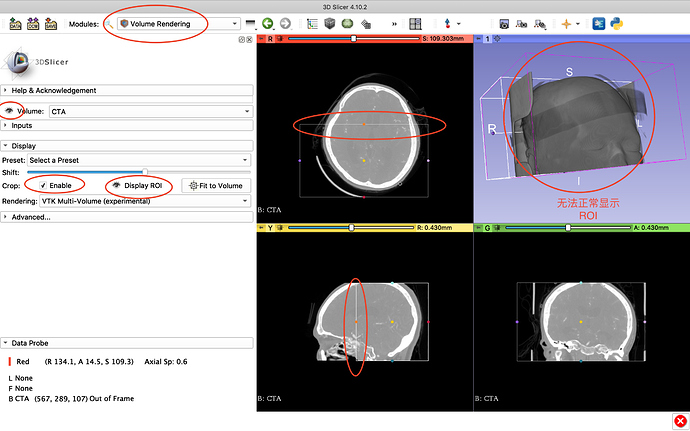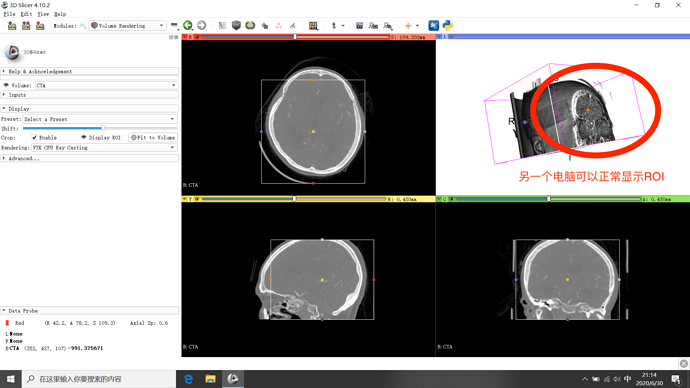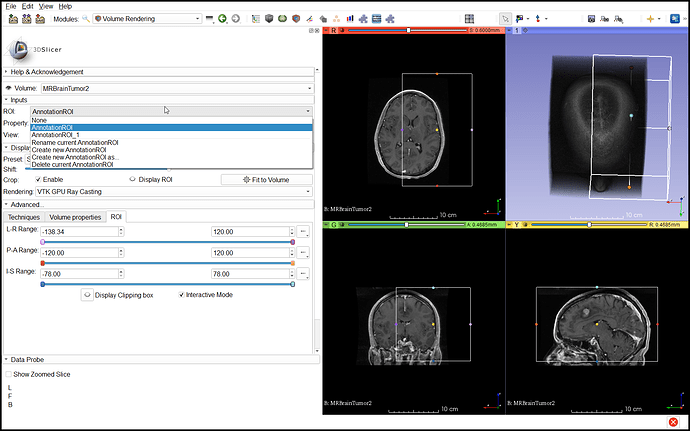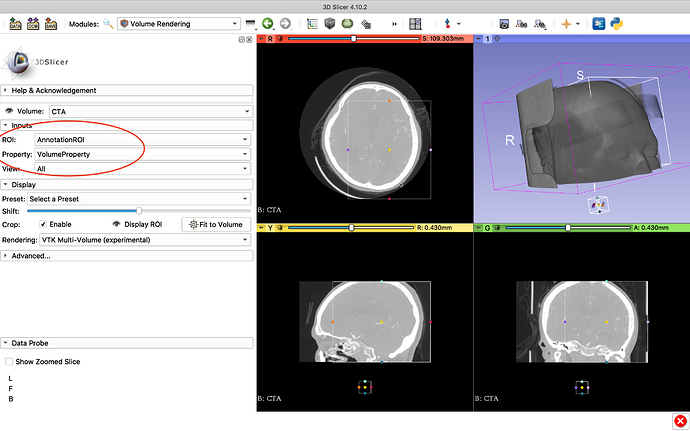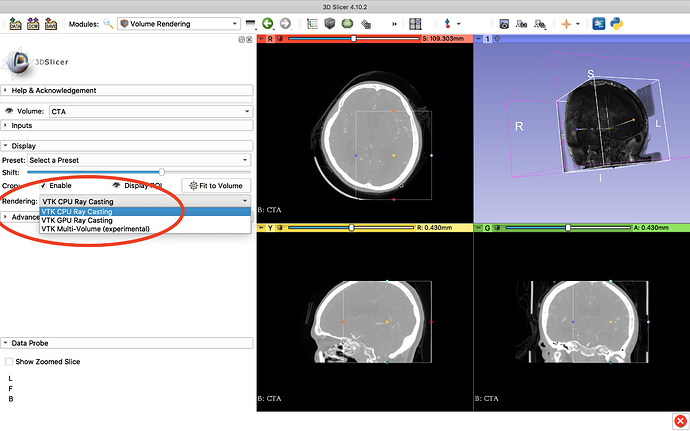软件版本:Mac系统 4.10.2
问题描述:1.打开Volume Rendering模块。加载CTA数据,点开“眼睛”,三维重建完成。2.点击enable 和display ROI,拖动ROI的线框,三维图像并未跟着切割。如第1幅图。
第一次使用的时候,我是可以正常显示ROI的,后来用了一段时间,不知道哪里设置更改后,就无法显示了。
我在别的电脑上,是可以正常显示的,如第2幅图。
苹果操作系统的渲染模式还有预设重新设置一下看看,没有苹果系统所以无法进行相应测试。
谢谢曹主任指导。上网苦苦找寻不到结果。然后又使用英文去检索这个问题。我发现国外也有人碰到这种问题(网址:https://discourse.slicer.org/t/rendered-volume-doesnt-show-slices-trough-roi/9215。如下)。但是最后也没有搞清楚,没有结果。她使用的是windows系统。
[Rendered volume doesn’t show slices trough ROI]
Dear all,
I have been trying to see patterns of variation in bone structures. For that, I am rendering a volume by using the Segment Editor module and applying ‘Threshold’ in a new added segment. After that, I am able to render the 3d image.
Then in the Volume Rendering module, I selected the CAA preset (but I didn’t see any difference) and clicked on the Display ROI function. I see the box and “vectors” indicating the function, but in any of them I am able to see through the rendered volume. It stays as a solid skeleton as the box travels through the image.
Can anyone help me with that? Should I render the volume differently so I can see through the slices in the rendered volume?
Thanks!
-Carolina
Operating system: Windows 10
Slicer version: 4.10.2
回答:
Slicer does not import bmp stacks as a scalar volume, it reads them RGB (vector volume). Once you imported your image stack you to invoke to vectortoscalar module. Alternatively, you can use SlicerMorph SkyscanReconImport (if your data is coming from a Bruker/Skyscan microCT. All you have to do i…
[/quote]
回答:
You can either show structures using by segmenting them using Segment Editor; or directly, without segmentation, using Volume rendering. If you show them both at the same time then most likely segmentation result occludes volume rendering result, so in order to see volume rendering, you need to hide the segmentation.
追问:
Thanks for the reply, but I’m still having trouble with that.
I have a bitmap stack files, and when I try to import them as a Scalar volume for taking the steps to the Volume rendering, my data doesn’t load and I end up with all black windows where the slices should appear.
回答:
Slicer does not import bmp stacks as a scalar volume, it reads them RGB (vector volume). Once you imported your image stack you to invoke to vectortoscalar module.
Alternatively,
- you can use SlicerMorph SkyscanReconImport (if your data is coming from a Bruker/Skyscan microCT. All you have to do is to point to the *_Rec.log file in the reconstruction folder). SlicerMorph is available as an extension for the preview builds.
- You can use https://github.com/pieper/SlicerImageStacks as shown on the webpage (copy and paste the python code)
Solution
9 DAYS LATER
追问:
Thank you!
I’ve downloaded the lastest preview version and was able to add SlicerMorph as an extension, but it didn’t solve my problem. Neither the Vector to Scalar module.
The link to GitHub did the trick, and I was able to render one of my many datasets.
In another one, I have the slices availabe in .tiff format. I run the script, and after loading the files to create the volume file, I get the following message:
Traceback (most recent call last):
File “C:/Users/Acer/AppData/Local/Temp/Slicer/SlicerImageStacks/SlicerImageStacks-master/ImageStacks/ImageStacks.py”, line 235, in onLoadButton
self.logic.loadByPaths(paths, self.currentNode(), properties)
File “C:/Users/Acer/AppData/Local/Temp/Slicer/SlicerImageStacks/SlicerImageStacks-master/ImageStacks/ImageStacks.py”, line 331, in loadByPaths
volumeArray[sliceIndex] = sliceArray
ValueError: could not broadcast input array from shape (700,316) into shape (805,1199)
Any idea what might be the issue? Thank you again for the help!
Carolina
回答:
It looks like you have a mix of Image sizes in the selection. Probably you only want to load equal sized images of the goal is to have a volume. Often there is something in the filename that indicates which ones go together.
最后也没有一个解决方案。
终于解决了。如下图,在Rendering里选择适合自己电脑的选项。因为我的电脑没有独立显卡,只能选择 VKT CPU Ray Casting。如果有独立显卡,可以试一试rendering VKT GPU Ray Casting。
松了一口气。也感谢曹主任的指导。
最终还是更改了渲染模式解决问题。
同样问题,选择了CPU渲染 得到解决。
建议有显卡的选择GPU
- VTK CPU Ray Casting: Available on all computers, regardless of capabilities of graphics hardware. The volume rendering is enterily realized on the CPU, therefore it is slower than other options.
- VTK GPU Ray Casting (default): Uses graphics hardware for rendering, typically much faster than CPU volume rendering. This is the recommended method for computers that have sufficiant graphics capabilities. It supports surface smoothing to remove staircase artifacts.
- VTK Multi-Volume: Uses graphics hardware for rendering. Can render multiple overlapping volumes. Currently does not support cropping.
一个是CPU 渲染,一个是GPU 渲染,还有第三个应该是多重渲染,CPU+GPU 一起渲染,我选择了这个,由于我的显卡不是很强,用这个之后发现3D视窗的显示效果好很多,以前旋转的时候图像会有颜色的变化,也会有锯齿,现在没有了。
哈哈,目前这个多数据渲染还不太成熟,不支持ROI剪切显示。
是多个Volume在一起显示。
